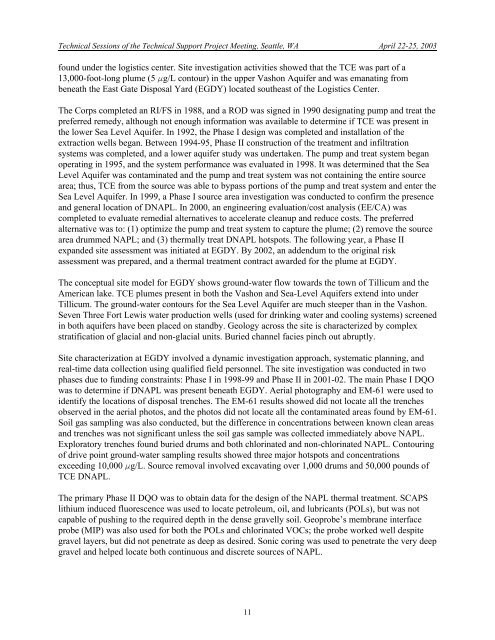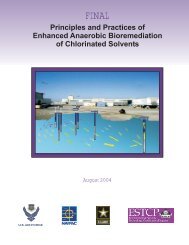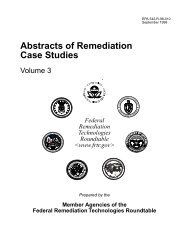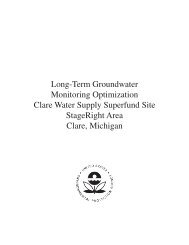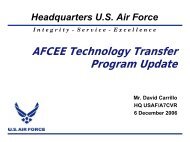Technical Sessions - Environmental Management Support, Inc.
Technical Sessions - Environmental Management Support, Inc.
Technical Sessions - Environmental Management Support, Inc.
You also want an ePaper? Increase the reach of your titles
YUMPU automatically turns print PDFs into web optimized ePapers that Google loves.
<strong>Technical</strong> <strong>Sessions</strong> of the <strong>Technical</strong> <strong>Support</strong> Project Meeting, Seattle, WA April 22-25, 2003<br />
found under the logistics center. Site investigation activities showed that the TCE was part of a<br />
13,000-foot-long plume (5 Fg/L contour) in the upper Vashon Aquifer and was emanating from<br />
beneath the East Gate Disposal Yard (EGDY) located southeast of the Logistics Center.<br />
The Corps completed an RI/FS in 1988, and a ROD was signed in 1990 designating pump and treat the<br />
preferred remedy, although not enough information was available to determine if TCE was present in<br />
the lower Sea Level Aquifer. In 1992, the Phase I design was completed and installation of the<br />
extraction wells began. Between 1994-95, Phase II construction of the treatment and infiltration<br />
systems was completed, and a lower aquifer study was undertaken. The pump and treat system began<br />
operating in 1995, and the system performance was evaluated in 1998. It was determined that the Sea<br />
Level Aquifer was contaminated and the pump and treat system was not containing the entire source<br />
area; thus, TCE from the source was able to bypass portions of the pump and treat system and enter the<br />
Sea Level Aquifer. In 1999, a Phase I source area investigation was conducted to confirm the presence<br />
and general location of DNAPL. In 2000, an engineering evaluation/cost analysis (EE/CA) was<br />
completed to evaluate remedial alternatives to accelerate cleanup and reduce costs. The preferred<br />
alternative was to: (1) optimize the pump and treat system to capture the plume; (2) remove the source<br />
area drummed NAPL; and (3) thermally treat DNAPL hotspots. The following year, a Phase II<br />
expanded site assessment was initiated at EGDY. By 2002, an addendum to the original risk<br />
assessment was prepared, and a thermal treatment contract awarded for the plume at EGDY.<br />
The conceptual site model for EGDY shows ground-water flow towards the town of Tillicum and the<br />
American lake. TCE plumes present in both the Vashon and Sea-Level Aquifers extend into under<br />
Tillicum. The ground-water contours for the Sea Level Aquifer are much steeper than in the Vashon.<br />
Seven Three Fort Lewis water production wells (used for drinking water and cooling systems) screened<br />
in both aquifers have been placed on standby. Geology across the site is characterized by complex<br />
stratification of glacial and non-glacial units. Buried channel facies pinch out abruptly.<br />
Site characterization at EGDY involved a dynamic investigation approach, systematic planning, and<br />
real-time data collection using qualified field personnel. The site investigation was conducted in two<br />
phases due to funding constraints: Phase I in 1998-99 and Phase II in 2001-02. The main Phase I DQO<br />
was to determine if DNAPL was present beneath EGDY. Aerial photography and EM-61 were used to<br />
identify the locations of disposal trenches. The EM-61 results showed did not locate all the trenches<br />
observed in the aerial photos, and the photos did not locate all the contaminated areas found by EM-61.<br />
Soil gas sampling was also conducted, but the difference in concentrations between known clean areas<br />
and trenches was not significant unless the soil gas sample was collected immediately above NAPL.<br />
Exploratory trenches found buried drums and both chlorinated and non-chlorinated NAPL. Contouring<br />
of drive point ground-water sampling results showed three major hotspots and concentrations<br />
exceeding 10,000 Fg/L. Source removal involved excavating over 1,000 drums and 50,000 pounds of<br />
TCE DNAPL.<br />
The primary Phase II DQO was to obtain data for the design of the NAPL thermal treatment. SCAPS<br />
lithium induced fluorescence was used to locate petroleum, oil, and lubricants (POLs), but was not<br />
capable of pushing to the required depth in the dense gravelly soil. Geoprobe’s membrane interface<br />
probe (MIP) was also used for both the POLs and chlorinated VOCs; the probe worked well despite<br />
gravel layers, but did not penetrate as deep as desired. Sonic coring was used to penetrate the very deep<br />
gravel and helped locate both continuous and discrete sources of NAPL.<br />
11


